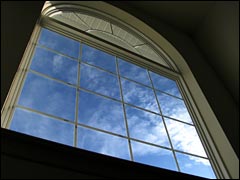Dear Umbra,
I am lucky enough to have a home I really love and food to feed my family and my pets. However, the home has one major energy flaw: it is older and has huge, single-pane window/walls with aluminum frames, in two adjoining rooms. We currently are not able to replace them, and they lose heat rapidly. With this winter being a bit colder, is there anything that you can suggest we do, other than the window upgrades we cannot afford, to keep some warmth in the house?
Justine
Concord, Calif.
Dearest Justine,
That sounds very chilly to be sure. I can’t pity you too much — at least you live in Concord, Calif., and not one of the other Concords — but if you think you’re cold, I believe you. Three winterization actions may help your situation: caulking, curtains, and storm windows. Weather-stripping is not an option for you with fixed-pane glass, so we’ll talk about that in another column.

Improving efficiency doesn’t have to be a pane.
Photo: iStockphoto
Take a little gander over at the Efficient Windows Collaborative site I mentioned in my last column to get an idea of how much money you will save in your climate when you replace your inefficient windows. That at least will help you plan toward window replacement, which is warranted with your conductive aluminum windows.
To dispense with curtains: the idea is simply that heavy curtains drawn over the windows at night have an insulating effect. New curtains can be expensive, but you can hang up blankets if you have extras.
To find out if caulking will be helpful, check the seal on your windows. You can do this by lighting a candle or incense stick, then passing it around all the edges where they meet your house. As you see the flame or smoke quiver less and more, you’ll learn a bit about how well the original installation caulking is holding up over time, and where the drafts are. (A windy day would help — and don’t set anything on fire.) If you find drafts, it is simple and inexpensive to reseal them with caulk. Ask for tips at the hardware store if you’ve never caulked, and you’ll avoid mass piles of goop.
Your windows are single pane, aka single glazed; double glazing is much better for warding off heat loss and gain. Since you can’t afford new, all-in-one, double-glazed windows with triple-e coating and argon and blah, blah, blah right now, storm windows are another way to achieve double glazing. Even the cheap plastic adhered with tape strips and a blow dryer is a sort of double glazing. That would be the most economical, and it is effective. Next step is to build or buy reusable storm windows.
A fixed-pane storm window is a large piece of plastic or glass encased in a wooden or aluminum frame, which is either permanent or seasonal, interior or exterior. It’ll fit into the window and stick in place with little toggles or hinges. Important components will be an excellent fit and weep holes at the bottom for condensation to exit if it is an exterior window. It should be airtight itself, or what’s the point? The Energy Efficiency and Renewable Energy guide at the Department of Energy has more to say on this point, and the American Council for an Energy-Efficient Economy does too (they won’t have you settle for an air leakage rate higher than 0.3 cfm/ft — 0.3 cubic feet per minute of air leakage per linear foot of window edge).
You can make storm windows yourself or buy them from another, and only you can make that decision. I’m not handy enough to make something square. If you are, various DIY websites or homebuilding magazine archives will have instructions — but, I repeat, I’m not handy enough to evaluate and recommend one.
I’ve been trying to figure out for myself how storm windows stack up against entirely new windows. Apparently they don’t particularly help with insulative properties, but do stop airflow; one public utility claims they provide a 25 to 50 percent reduction in heat loss during the winter. Sounds good to me, and hopefully affordable to you.
Caulky,
Umbra


